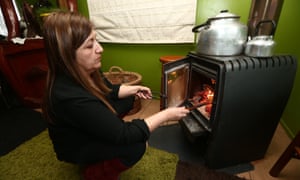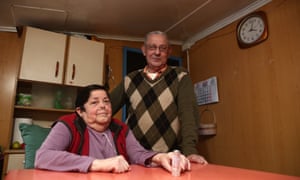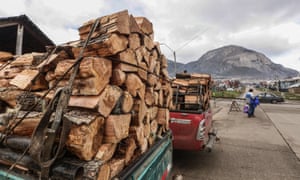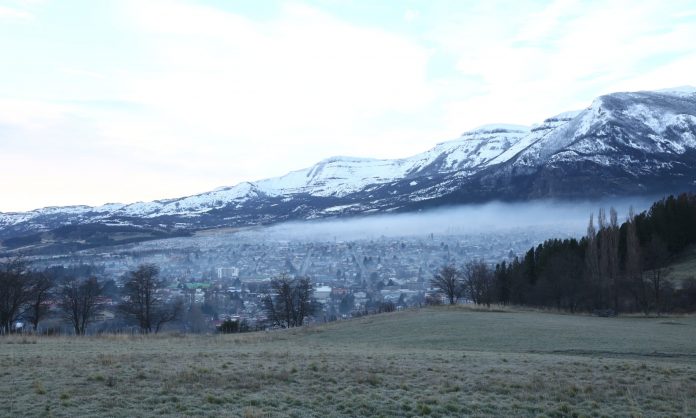Wood smoke smothers Coyhaique, Chile, in June and July. Yet despite the WHO ranking its air worst in the Americas, residents are reluctant to alter their habits
Photographs by Claudio Frías
by John Bartlett in Coyhaique
Every evening through the bitterly cold winter months of June and July, the southern city of Coyhaique, the most populous in the region of Aysén in Chilean Patagonia, is smothered by a thick, fragrant blanket of damp wood smoke that clings to the hillsides.
With the city lying between two mountainous ridges – to the west lies the Pacific Ocean and behind the steep rise on the other side of the valley is Argentina – there is very little wind to sweep the smoke down the valley and away. Instead, heat inversion compresses the cloud into a dense shield that suffocates the city.
A 2018 study by the World Health Organization (WHO) looking at 4,357 cities in 108 countries worldwide showed Coyhaique to have the worst air quality in the Americas – and ranked it 139th unhealthiest in the world.
“Coyhaique is confined to an area that is incredibly unfavourable in terms of ventilation,” says Nicolás Huneeus, an assistant professor at the University of Chile’s geophysics department in Santiago who works to monitor air pollution up and down the country. “Add low temperatures and cheap firewood to the mix, and the problem isn’t one that we can solve without a sustained, coordinated effort.”

- Yasna Seguel says she would not change to a cleaner fuel even if it was cheaper than the logs she currently burns
In May 2016, the Chilean government declared Coyhaique “saturated” by harmful fine particles (PM2.5) which are linked to cardiopulmonary diseases and lung cancer. WHO guidelines stipulate that the concentration of these PM2.5 levels should not exceed an average of 25 μg/m3 over a 24-hour period.
Already this year, Coyhaique has entered the environment ministry’s “pre-emergency” day average range 19 times, set at between 110 and 179μg/m3 concentration of PM2.5 particles, and risen to “emergency” levels of more than 180μg/m3 on 11 occasions. On these emergency days, Coyhaiquinos can only use one heater per home and open fires are banned. Outdoor exercise is also restricted, with school children forced to stay indoors.
Despite the pollution many residents are reluctant to move away from wood as a fuel source.

- A street in the eastern suburbs of Coyhaique shrouded in smoke
Having moved to the city more than 50 years ago, Marta Muñoz has developed a chronic respiratory condition and has to be connected to an oxygen supply at all times. Her condition prompted her husband, Luís Espinoza, to remove the wood-burning stove from their kitchen three years ago, replacing it with two paraffin heaters; Muñoz says she misses the warmth of a wood fire.
“We used to be able to roast a whole lamb in our oven while warming the house at the same time,” she remembers fondly, gazing out of the window to where the stove now stands in the cold yard.
Despite the hazardous PM2.5 levels, Coyhaique is below the national average for incidence of respiratory illnesses, and cardiovascular diseases are only the second cause of death in Aysén behind cancers, whereas they are first overall in Chile. Nonetheless, according to data from the city’s regional hospital, respiratory complaints have been the main cause of admission in Coyhaique every year since 2016 – as well as in the first half of this year.

- Marta Muñoz and Luis Espinoza. When Muñoz developed a chronic respiratory condition, Espinoza removed the kitchen’s wood-burning stove
Shuffling across to sit on a wooden stool beside the open fire grate, her grandson’s woollen clothes drying on a low rack behind the stove and a tin kettle whistling gently on top, Seguel explains that she would not change to a cleaner, emission-reducing fuel either – even if it were cheaper than the sacks of dried logs she buys each day. “The heat from the wood warms the whole house and it’s so pleasing! With other fuels, as soon as they burn out the room goes cold, whereas wood embers burn on for hours,” she says.
Seguel has recently applied for a national government grant to insulate her home, which she bought from the state eight years ago but which is inadequately clad for the winter months. Away from Coyhaique’s clusters of social housing, the quality of construction in other parts of the city – which is largely informal and unregulated – is a perennial issue that goes beyond fuel choices.

- Firewood loaded on to trucks in downtown Coyhaique
One of the environment ministry’s flagship programmes involves the exchange of wood-burning stoves for a cleaner alternative that burns kerosene pellets. Residents who have a wood fire in their houses can apply to have their stove taken away and destroyed, replaced with a pellet stove by the environment ministry free of charge. Although take-up has been steady since the programme began in 2011, it has not been easy to persuade Coyhaiquinos to give up their firewood for the slightly more expensive but cleaner kerosene.
A number of other programmes and subsidies have also targeted emissions reductions. A scheme to certify the dryness of wood has been renewed for this year, with sellers given a window that closes on 31 July to formalise their businesses and demonstrate that the wood they sell is properly dried. A regional heating system – the first programme of its kind in Chile – will take an initial set of 90 homes to be heated and provided with hot water from biomass heaters, with potential for the project to be expanded to 1,095 homes.

- Firewood for sale in a truck in Coyhaique
Daniela Rauld, who leads the municipal government’s evaluation group, says attitudes must change. “In order to make this cultural shift, we have to find a solution that tackles the root cause of the problem that is both technically and economically viable,” she says.
Coyhaiquinos are well aware that their air quality is poor in winter – they get told often enough – but not all are willing yet to make a change to the traditions they have grown up with.
Rauld believes regulation needs to be taken more seriously. “If you drive past with a lorry full of fake leather jackets, the police will pull you over and issue a fine, naturally,” she adds. “But lorryloads of wood drive past day after day, that pollute our air and don’t contribute taxes, and nobody says anything!”
Leer en The Guardian.

